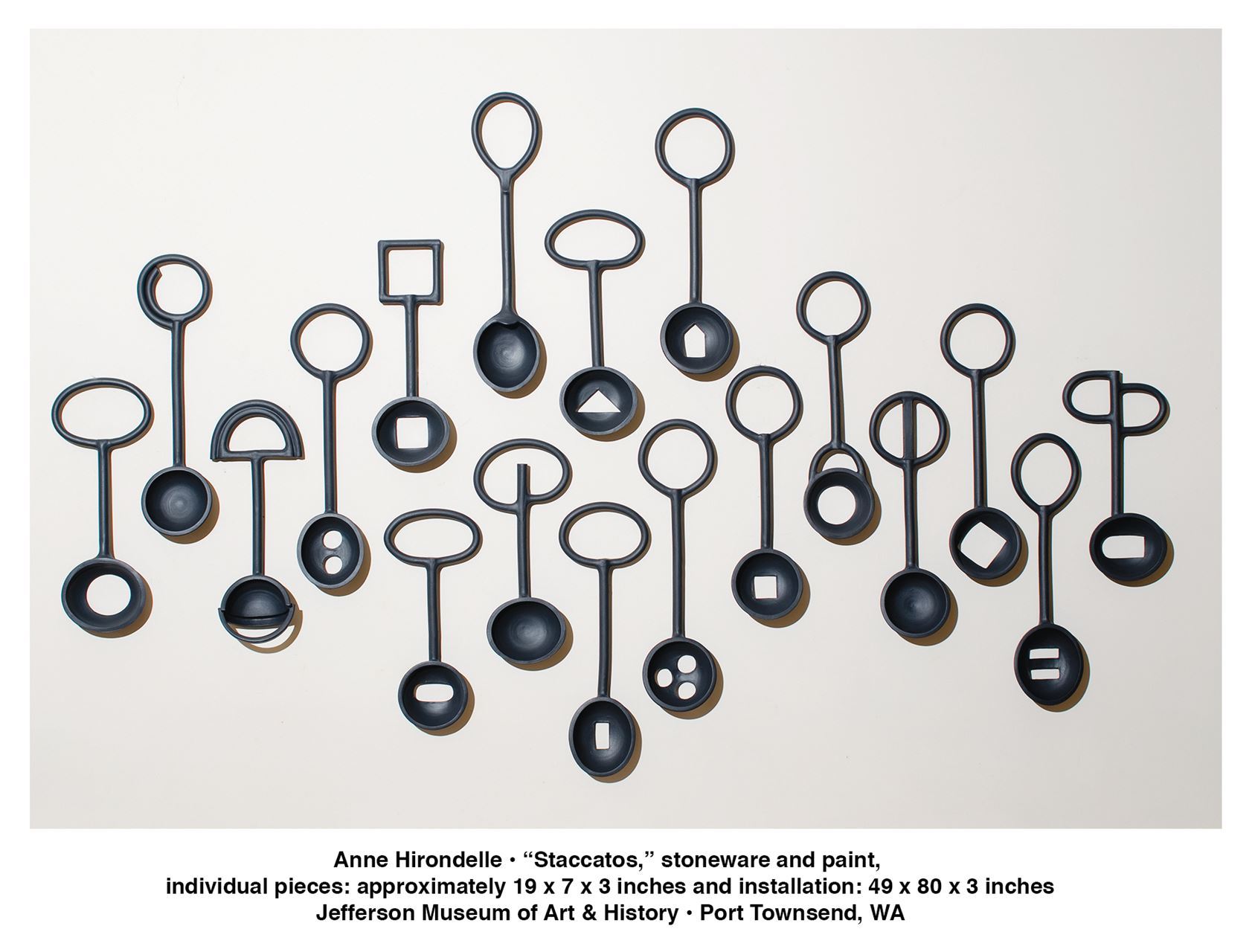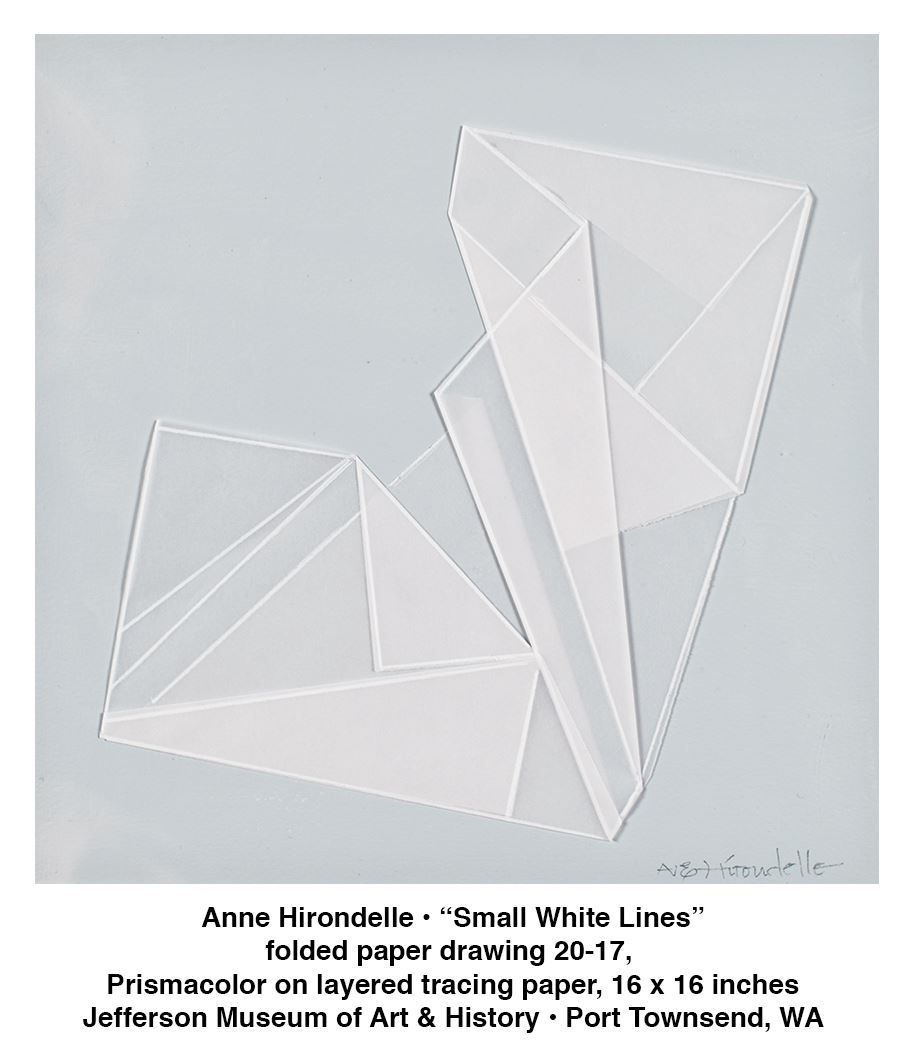
“Not Done Yet” is an apt title for an exhibition featuring an artist like Anne Hirondelle. As renowned Seattle gallerist Francine Seders describes in the exhibition catalogue, Hirondelle is an artist who continued to evolve even when some may have thought her work was perfected. It is challenging to imagine changing your artistic style so drastically, especially when the artworks are so popular. In the early 2000s Hirondelle took a risk, but it is not accurate to say that she completely changed direction. Her goals evolved and shifted, but she was not done yet examining and dissecting her forms. “Not Done Yet” is a continuation of the series of discoveries that Hirondelle made in her career and continues to make to this day.
 Hirondelle’s exhibition is divided into two galleries and traces her exploration of form. The main exhibition space includes artworks from 2002 to the present, while her earlier artworks are installed in the smaller gallery downstairs. Hirondelle began her artistic career creating functional objects and trained with Robert Sperry in the University of Washington ceramics department. But in 2002, her focus shifted from a vessel that contains to an open sculptural form. Her continuing examination of form and line is the thesis of the show, “Not Done Yet,” as Hirondellle focuses more on works on paper. These artworks create a wonderful dichotomy between the vessel as a 3-dimentional object versus a 2-dimenstional plane.
Hirondelle’s exhibition is divided into two galleries and traces her exploration of form. The main exhibition space includes artworks from 2002 to the present, while her earlier artworks are installed in the smaller gallery downstairs. Hirondelle began her artistic career creating functional objects and trained with Robert Sperry in the University of Washington ceramics department. But in 2002, her focus shifted from a vessel that contains to an open sculptural form. Her continuing examination of form and line is the thesis of the show, “Not Done Yet,” as Hirondellle focuses more on works on paper. These artworks create a wonderful dichotomy between the vessel as a 3-dimentional object versus a 2-dimenstional plane.
Anne Hirondelle was born in Vancouver, Washington and grew up in Oregon. She has a Bachlor of Arts in English, an Masters of Art in Counseling, and studied Law at the University of Washington in the early 1970s. Thankfully, Hirondelle shifted her attention to sculpture and studied ceramics at the University of Washington. She received a Visual Artist Fellowship from the National Endowment for the Arts in 1988, was a finalist for the Seattle Art Museum Betty Bowen Award in 2004, and was acknowledge as a Creating a Living Legacy Artist by the Joan Mitchell Foundation in 2014. She has exhibited her work in countless galleries and many prominent museums in the Northwest, and her artworks are a staple in the homes of many art collectors in the region and beyond.
 Since the museum is currently closed due to COVID-19, a written description of the exhibition has to suffice until the public can once again visit. A bright yellow wall greets visitors and educates about Ann Hirondelle’s life as an artist. There is also a quote by Hirondelle which sums up her artistic explorations beautifully: “I think one of the challenges of being a really good artist is not more and more, but less and less; really stretching what you know and what you can do. That is where you find your own self: in the limitations, not the additions.”
Since the museum is currently closed due to COVID-19, a written description of the exhibition has to suffice until the public can once again visit. A bright yellow wall greets visitors and educates about Ann Hirondelle’s life as an artist. There is also a quote by Hirondelle which sums up her artistic explorations beautifully: “I think one of the challenges of being a really good artist is not more and more, but less and less; really stretching what you know and what you can do. That is where you find your own self: in the limitations, not the additions.”
The exhibit includes a large installation, “Staccatos,” of 18 black stoneware sculptures and it’s one of the first artworks on view. The main gallery consists of wall-mounted sculptures, drawings, and many artworks on pedestals. The room is striking, and it seems to glow as the brightly painted sculptures are highlighted against white walls. Hirondelle’s round forms are soft yet crisp, both organic and exact. Teal, royal blue, orange, purple, and red are visual pops that create a real visual delight. But there are many black and white vessels and drawings as well. In one view, the visitor can see a two-dimensional drawing of a circular form that is then deconstructed and expanded into the sculpture on the pedestal below.
 There is a series of three installations that include nine objects each. The sculptures are reminiscent of a larger installation from 2012, “Sixteen Ways of Looking at a Blackbird.” These sculptures are an excellent example of Hirondelle’s examination of the circular form and there is a long artistic lineage in the search to capture the complete view of an object. Hirondelle’s sculptures appear to be the same object just rotated over and over again until the viewer can see on one visual picture frame the complete object. Similar to Cézanne, she is seeking to create a complex view of a three-dimensional object.
There is a series of three installations that include nine objects each. The sculptures are reminiscent of a larger installation from 2012, “Sixteen Ways of Looking at a Blackbird.” These sculptures are an excellent example of Hirondelle’s examination of the circular form and there is a long artistic lineage in the search to capture the complete view of an object. Hirondelle’s sculptures appear to be the same object just rotated over and over again until the viewer can see on one visual picture frame the complete object. Similar to Cézanne, she is seeking to create a complex view of a three-dimensional object.
A smaller gallery contains earlier works by Hirondelle when she was creating functional objects, as well as a few pieces of archival material. The vessels are displayed side-by-side and range from small teacups to large pitchers. All have one key similarity: graceful use of line. Hirondelle created these objects to be functional, but the origins of her later work is evident. It is incredible to see so many artworks by one artist in a single exhibition, and even more enlightening to see how their work evolved over the decades. The message is truly inspiring: Hirondelle isn’t done yet, and we must all keep moving forward because there is more to discover.
Chloé Dye Sherpe
Chloé Dye Sherpe is a curator and art professional based in Washington State.
The Jefferson Museum of Art & History, located at 540 Water Street in Port Townsend, Washington, plans to extend the exhibition through the summer once it is safe to reopen. Until then, visit www.jchsmuseum.org, for more information and to find out about online programming.